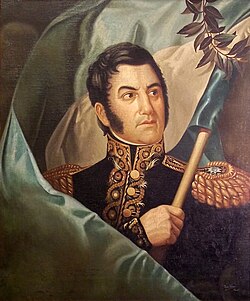José de San Martín
|
General Don José de San Martín |
|
|---|---|
 |
|
| Protector of Peru | |
|
In office 28 July 1821 – 20 September 1822 |
|
| Succeeded by | Francisco Xavier de Luna Pizarro |
| Founder of the Freedom of Peru, Founder of the Republic, Protector of Peru, and Generalissimo of Armas (ad honorem) |
|
|
In office 20 September 1822 – 17 August 1850 (death) |
|
| Governor of Cuyo | |
|
In office 10 August 1814 – 24 September 1816 |
|
| Preceded by | Marcos González de Balcarce |
| Succeeded by | Toribio de Luzuriaga |
| Personal details | |
| Born |
25 February 1778 Yapeyú, Corrientes, Viceroyalty of the Río de la Plata (now Argentina) |
| Died | 17 August 1850 (aged 72) Boulogne-sur-Mer, France |
| Nationality | Argentina |
| Political party | Patriot |
| Spouse(s) | María de los Remedios de Escalada y la Quintana |
| Children | María de las Mercedes Tomasa de San Martín y Escalada |
| Profession | Military |
| Religion | Roman Catholicism |
| Signature |  |
| Military service | |
| Allegiance |
|
| Years of service | 1789–1822 |
| Rank | General of Argentina, Commander-in-Chief of the armies of Chile and Peru |
| Commands | Regiment of Mounted Grenadiers, Army of the North, Army of the Andes, Chilean Army |
| Battles/wars | |
War of the Second Coalition
War of the Oranges
Peninsular War
Spanish American wars of independence
José Francisco de San Martín y Matorras (25 February 1778 – 17 August 1850), known simply as José de San Martín (Spanish pronunciation: [xoˈse ðe san marˈtin]), was an Argentine general and the prime leader of the southern part of South America's successful struggle for independence from the Spanish Empire who served as the Protector of Peru (first President of Peru). Born in Yapeyú, Corrientes, in modern-day Argentina, he left his mother country at the early age of seven to study in Málaga, Spain.
In 1808, after taking part in the Peninsular War against France, San Martín contacted South American supporters of independence from Spain. In 1812, he set sail for Buenos Aires and offered his services to the United Provinces of the Río de la Plata, present-day Argentina. After the Battle of San Lorenzo and time commanding the Army of the North during 1814, he organized a plan to defeat the Spanish forces that menaced the United Provinces from the north, using an alternative path to the Viceroyalty of Peru. This objective first involved the establishment of a new army, the Army of the Andes, in Cuyo Province, Argentina. From there, he led the Crossing of the Andes to Chile, and triumphed at the Battle of Chacabuco and the Battle of Maipú (1818), thus liberating Chile from royalist rule. Then he sailed to attack the Spanish stronghold of Lima, Peru.
...
Wikipedia
